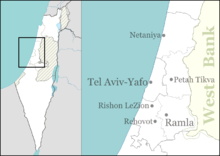Ayalon Cave
| Ayalon Cave | |
|---|---|
 Large chamber with cave lake in Ayalon Cave | |
| Location | Ramla, Israel |
| Coordinates | 31°54′37″N 34°55′39″E / 31.91028°N 34.92750°E |
| Depth | 100 metres (330 ft) |
| Length | 2,700 metres (8,900 ft) |
| Discovery | 2006 |
| Geology | Limestone |
The Ayalon Cave (
Discovery and description
According to historian Roy Marom, the existence of significant caves on the site was known to the ancients. In the 16th century, the site is recorded as Mazraʽat šīḥah /Mazraʽat šīḥa/ [54], “the farm of the pit, cavity, ditch”, from Aramaic šyḥ’, exemplifiying and motivated by the fact that the site has dozens of caves and underground caverns. In the 19th century, the site was known as muġur šīḥa ("Shiha Caves").[3]
The cave was rediscovered in 2006 when a small opening was discerned in the quarry.[4]
The cave, 100 metres (330 ft) deep, extends 2,700 metres (8,900 ft) including its branches, which makes it the third-largest limestone cave in Israel.[5]
Significance
According to Professor
Ecosystem
Photosynthesis-free food chain
As the cave was completely cut off from the outside environment, it sustained an independent
New species
Researchers announced that they had discovered eight species previously unknown to science, all without eyes, comprising four aquatic crustacean species and four other species of terrestrial crustaceans and springtails.[5]
A species of eyeless
2021 destruction threat averted
The cave is located on the premises of a limestone quarry owned by the cement manufacturing Nesher Industries.
Scientists argued that a massive influx of surface runoff water, which is totally different from the groundwater on which the unique cave ecosystem is based, would be sure to destroy it.[1] The intervention by Israeli and foreign researchers and the public petition has saved the cave's ecosystem, the authorities deciding for a different technical solution.[6]
Access
The cave is not accessible to the public. Only a small number of researchers are allowed to enter.[5]
See also
- Ophel biome, proposed worldwide biome supporting similar ecosystems
- Similar caves where life partly or fully depends on chemosynthesis:
- Typhlocaris galilea, cave-dwelling blind shrimp and relative of one of the Ayalon Cave species, found only in Ein-Nur Cave
- Subterranean fauna
- Troglofauna, small animals living in caves
- Stygofauna, fauna living in groundwater and aquifers
- Nesher Ramla Homo, hominin population whose fossils were discovered in the same area[9]
- Nesher-Ramla hiding complex (1st century BCE-1st c. CE) also discovered within the Nesher quarry
- Soreq Cave, relatively nearby show cave
- Geography of Israel
- Wildlife of Israel
References
- ^ Times of Israel. 4 June 2021. Retrieved 22 March 2024.
- ^ "Unique Underground Ecosystem Revealed by Hebrew University Researchers Uncovers Eight Previously Unknown Species." Hebrew University Press release, 31 May 2006. Re-accessed 22 March 2024.
- ^ Marom, Roy; Zadok, Ran (2023). "Early-Ottoman Palestinian Toponymy: A Linguistic Analysis of the (Micro-)Toponyms in Haseki Sultan's Endowment Deed (1552)". Zeitschrift des Deutschen Palästina-Vereins. 139 (2).
- ^ "Scientists Discover Prehistoric Cave With Eight New Species in Ramle". Haaretz. Retrieved 2024-02-25.
- ^ a b c d e "One year later, 'Noah's Ark' cave is no longer a safe haven". Haaretz. 19 July 2007. Retrieved September 16, 2018.
- ^ "Unique Ayalon Cave ecosystem saved from destruction", Lior Peleg for Israel Hayom, 14 Sep 2021. Accessed 22 March 2024.
- ^ Sârbu, Şerban M. "The fascinating biology of stinky caves", - ARPHA Conference Abstracts, 25th International Conference on Subterranean Biology, Cluj-Napoca, 18-22 July 2022. Re-accessed 23 March 2024.
- ^ Chiciudean, I., Russo, G., Bogdan, D.F. et al. "Competition-cooperation in the chemoautotrophic ecosystem of Movile Cave: first metagenomic approach on sediments." Environmental Microbiome 17, 44 (2022). Permanent doi
.org /10 .1186 /s40793-022-00438-w . Re-accessed 23 March 2024. - ^ "The True History of Ancient Jewish Underground Hiding Places in Israel". Ariel David for Haaretz. 18 January 2024. Retrieved 22 March 2024.
External links
- National Geographic
- A. Frumkin and H. Gvirtzman (2006). "Cross-formational rising groundwater at an artesian karstic basin: the Ayalon Saline Anomaly, Israel" (PDF). Journal of Hydrology. 318 (1–4): 316–333. doi:10.1016/j.jhydrol.2005.06.026. Archived from the original(PDF) on 2011-07-19. Retrieved 2010-07-02.

